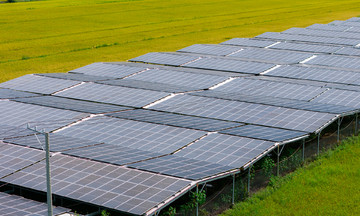At a seminar on energy market development organized by Bao Xay dung on 8/10, Mr. Tran Hoai Trang, Deputy Director of the Electricity Regulatory Authority (Ministry of Industry and Trade), stated that the ministry is directing Vietnam Electricity (EVN) to promptly implement a pilot program for two-component electricity pricing starting in October.
According to the Electricity Regulatory Authority, the pilot will apply to customers consuming an average of more than 200,000 kWh per month, corresponding to approximately 7,000 establishments. Following this phase, the operator will evaluate the results and decide whether to implement two-component electricity pricing.
 |
Mr. Tran Hoai Trang, Deputy Director of the Electricity Regulatory Authority (Ministry of Industry and Trade), speaks at the seminar on 8/10. *Photo: Bao Xay dung* |
Vietnam currently uses a single-component pricing system, where customers pay based solely on consumption. This method does not accurately reflect the electricity sector's costs, such as asset depreciation, transmission lines, and substations, for each customer. With two-component pricing, which includes charges based on consumed output and registered capacity, customers will pay separately for each kilowatt of capacity they register monthly with the provider. Even when not using power, they will still incur this capacity charge, rather than the electricity sector absorbing it and recovering it through price adjustments, as is the current practice.
Previously, the Ministry of Industry and Trade proposed implementing this pricing mechanism in 4 phases. Phase 1, from now until mid-next year, will pilot this mechanism with manufacturing businesses engaged in direct power purchase agreements between renewable energy generators and large electricity consumers (manufacturing, commercial).
During this phase, the Ministry of Industry and Trade will survey and collect all metering data, such as electricity consumption and usage patterns. From this, they will research and propose a calculation method suitable for the input parameters and the customer groups that will undergo the official trial.
According to Mr. Nguyen Quoc Dung, EVN's Head of Business Department, two-component electricity pricing has been adopted by many countries because it is considered the most accurate calculation method, effectively meeting load demands.
Mr. Dung assessed that Vietnam's current technical infrastructure is robust, with electronic meters capable of remote data collection and determining capacity every 30 minutes. The transmission infrastructure is also strong, providing a fundamental condition for implementing two-component electricity pricing.
An EVN representative stated that two-component electricity pricing is expected to more accurately reflect the system's investment costs required to ensure sufficient capacity supply for users. For example, under the current single-component pricing, two households with similar usage purposes and consumption volumes would pay the same electricity bill. However, with two-component pricing, while they would pay the same energy charge, the capacity charge would depend on the customer's usage behavior.
"Previously, users aiming to save electricity needed to reduce their energy consumption, but now they can achieve this by optimizing their usage methods," Mr. Dung said. Thus, according to the EVN representative, users can choose to adjust their behavior and usage patterns to lower their registered capacity, thereby reducing costs.
In practice, retail electricity price reform should be considered as Vietnam transitions to a market mechanism for power generation, wholesale, and retail. However, implementing two-component pricing will impact various customer groups and electricity users, as the amount payable could increase or decrease compared to the current system. Therefore, changing the electricity pricing mechanism requires an appropriate roadmap, coupled with communication efforts to build consensus.
Phuong Dung












